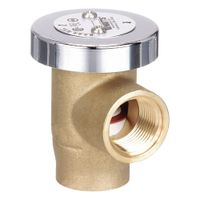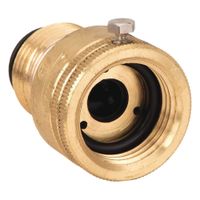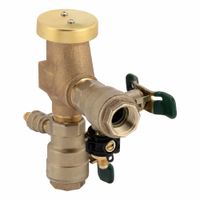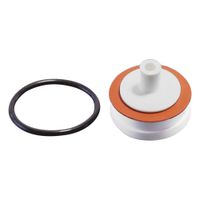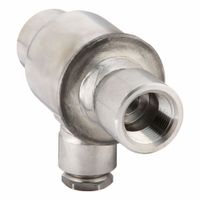Call +(254) 703 030 000 / 751 483 999 / 721 704 777
- Home
- Plumbing
- Plumbing Valves
- Backflow Prevention Valves
- Vacuum Breaker Valves
Frequently Asked Questions
What is a vacuum breaker valve and how does it work?
A vacuum breaker valve is a device designed to prevent backflow and siphoning in plumbing systems, ensuring that contaminated water does not flow back into the clean water supply. It is commonly used in applications such as irrigation systems, toilets, and outdoor faucets.
The vacuum breaker valve operates by allowing air to enter the system when a vacuum is detected. It typically consists of a spring-loaded check valve that remains closed under normal pressure conditions. When the pressure inside the system drops below atmospheric pressure, the vacuum breaker opens, allowing air to enter. This influx of air breaks the vacuum, preventing the reverse flow of water.
In operation, when water flows normally, the pressure keeps the valve closed, maintaining a seal that prevents air from entering. If the water supply is interrupted or the pressure drops, the valve opens due to the spring mechanism, allowing air to fill the void. This action stops the siphoning effect, which could otherwise draw contaminated water back into the clean water supply.
Vacuum breaker valves are crucial for maintaining water safety and are often required by plumbing codes in various jurisdictions. They are typically installed at high points in the plumbing system to ensure effective operation. These valves are available in different types, including atmospheric and pressure vacuum breakers, each suited for specific applications and pressure conditions.
Why is a vacuum breaker important for preventing backflow?
A vacuum breaker is crucial for preventing backflow because it serves as a mechanical device designed to maintain the integrity of potable water systems by preventing the reverse flow of contaminated water. Backflow can occur due to back siphonage or back pressure, both of which can introduce pollutants or contaminants into clean water supplies.
The vacuum breaker operates by allowing air to enter the system when a vacuum or negative pressure is detected. This influx of air breaks the siphon effect that could otherwise draw contaminated water back into the clean water supply. By doing so, it ensures that the water flow remains unidirectional, maintaining the separation between potable and non-potable water.
In situations where water pressure drops, such as during a mainline break or heavy water usage, the risk of back siphonage increases. A vacuum breaker automatically opens to admit air, equalizing the pressure and preventing the reverse flow. This is particularly important in systems where water outlets are below the level of the water source, such as in irrigation systems, laboratory equipment, or industrial processes.
Moreover, vacuum breakers are often mandated by plumbing codes and regulations to ensure public health and safety. They are typically installed in locations where there is a high risk of contamination, such as hose bibs, outdoor faucets, and other points of potential cross-connection.
In summary, a vacuum breaker is a vital component in safeguarding water quality by preventing backflow, thereby protecting public health and ensuring compliance with safety standards.
How do you install a vacuum breaker on a hose bibb?
1. **Turn Off Water Supply**: Locate the main water supply valve for the hose bibb and turn it off to prevent water flow.
2. **Drain the Hose Bibb**: Open the hose bibb to release any remaining water in the line.
3. **Clean the Threads**: Ensure the threads on the hose bibb are clean and free of debris or corrosion. Use a wire brush if necessary.
4. **Select the Correct Vacuum Breaker**: Choose a vacuum breaker that matches the size and thread type of your hose bibb.
5. **Apply Teflon Tape**: Wrap Teflon tape around the threads of the hose bibb to ensure a watertight seal. Wrap in the direction of the threads to prevent unraveling.
6. **Attach the Vacuum Breaker**: Screw the vacuum breaker onto the hose bibb by hand. Ensure it is aligned properly and tighten it securely. Use a wrench if necessary, but avoid over-tightening to prevent damage.
7. **Secure the Set Screw**: If the vacuum breaker has a set screw, tighten it with a screwdriver to lock the device in place.
8. **Test the Installation**: Turn the water supply back on and check for leaks. Open the hose bibb to ensure water flows properly and the vacuum breaker functions correctly.
9. **Inspect for Leaks**: Observe the connection for any signs of water leakage. Tighten connections if necessary.
10. **Final Check**: Ensure the vacuum breaker is functioning by turning off the water and observing if it prevents backflow.
11. **Maintenance**: Periodically check the vacuum breaker for proper operation and replace it if it shows signs of wear or damage.
What are the differences between pressure vacuum breakers and atmospheric vacuum breakers?
Pressure vacuum breakers (PVBs) and atmospheric vacuum breakers (AVBs) are both backflow prevention devices, but they have distinct differences:
1. **Design and Operation**:
- **PVB**: Consists of a spring-loaded check valve and an air inlet valve. It is designed to prevent backflow by opening the air inlet valve when the pressure drops, allowing air to enter and break the vacuum.
- **AVB**: Simpler design with a float and air inlet valve. It relies on atmospheric pressure to open the air inlet when the water flow stops, preventing back siphonage.
2. **Installation**:
- **PVB**: Can be installed in-line and is suitable for continuous pressure applications. It must be installed at least 12 inches above the highest downstream outlet.
- **AVB**: Must be installed downstream of the last control valve and at least 6 inches above the highest outlet. It cannot be subjected to continuous pressure for more than 12 hours.
3. **Usage**:
- **PVB**: Suitable for systems where the water supply is under constant pressure, such as irrigation systems.
- **AVB**: Best for systems that are not under constant pressure, like hose bibs or single fixture applications.
4. **Maintenance**:
- **PVB**: Requires regular testing and maintenance due to its more complex mechanism.
- **AVB**: Generally requires less maintenance due to its simpler design.
5. **Cost**:
- **PVB**: Typically more expensive due to its complexity and capability to handle continuous pressure.
- **AVB**: Less expensive and simpler, but with limitations on usage.
6. **Regulations**:
- **PVB**: Often required by codes for certain applications due to its reliability under continuous pressure.
- **AVB**: Limited by codes to non-continuous pressure applications.
How do you maintain or repair a vacuum breaker valve?
To maintain or repair a vacuum breaker valve, follow these steps:
1. **Inspection**: Regularly inspect the valve for signs of wear, corrosion, or damage. Check for leaks or unusual noises during operation.
2. **Cleaning**: Turn off the water supply and relieve pressure. Remove the valve cap and clean internal components with a soft brush and mild detergent. Rinse thoroughly to remove debris and mineral deposits.
3. **Seal Check**: Examine the rubber seals and gaskets for cracks or wear. Replace any damaged seals to ensure a proper seal and prevent leaks.
4. **Lubrication**: Apply a suitable lubricant to moving parts to ensure smooth operation. Avoid petroleum-based lubricants as they can degrade rubber components.
5. **Reassembly**: Carefully reassemble the valve, ensuring all components are correctly aligned and tightened. Avoid over-tightening, which can damage threads or seals.
6. **Testing**: Turn the water supply back on and test the valve for proper operation. Check for leaks and ensure the valve opens and closes smoothly.
7. **Replacement**: If the valve is severely damaged or fails to function after maintenance, consider replacing it. Ensure the new valve is compatible with your system.
8. **Regular Maintenance**: Schedule regular maintenance checks to prolong the valve's lifespan and ensure reliable operation. This includes periodic cleaning and inspection.
By following these steps, you can maintain or repair a vacuum breaker valve effectively, ensuring it functions properly and prevents backflow in your plumbing system.
What are common signs that a vacuum breaker needs replacement?
Common signs that a vacuum breaker needs replacement include:
1. **Leaking Water**: Persistent dripping or water pooling around the vacuum breaker indicates a seal failure or internal damage.
2. **Reduced Water Pressure**: A noticeable drop in water pressure can suggest that the vacuum breaker is not functioning properly, possibly due to blockages or internal wear.
3. **Hissing or Whistling Sounds**: Unusual noises such as hissing or whistling during operation can signal air leaks or pressure imbalances within the vacuum breaker.
4. **Visible Corrosion or Rust**: Corrosion or rust on the vacuum breaker can compromise its structural integrity, leading to potential failure.
5. **Cracks or Physical Damage**: Any visible cracks or damage to the vacuum breaker housing can affect its performance and necessitate replacement.
6. **Frequent Activation**: If the vacuum breaker activates more frequently than usual, it may indicate a malfunction or improper installation.
7. **Water Hammer**: Loud banging noises in the pipes, known as water hammer, can occur if the vacuum breaker is not effectively regulating pressure changes.
8. **Backflow Issues**: If there is evidence of backflow, such as contaminated water or unusual tastes and odors, the vacuum breaker may not be preventing reverse flow as intended.
9. **Age and Wear**: Over time, components can wear out. If the vacuum breaker is old and showing signs of wear, it may be time for a replacement.
10. **Failure to Pass Inspection**: If a professional inspection reveals that the vacuum breaker is not up to code or functioning properly, replacement is necessary.
Regular maintenance and inspections can help identify these issues early, ensuring the vacuum breaker operates effectively and prevents potential water system contamination.
Can vacuum breakers be used in all types of plumbing systems?
No, vacuum breakers cannot be used in all types of plumbing systems. Vacuum breakers are backflow prevention devices designed to prevent the reverse flow of water, which can lead to contamination of potable water supplies. They are typically used in systems where there is a risk of back siphonage, such as in irrigation systems, hose bibs, and certain types of fixtures.
However, vacuum breakers are not suitable for all plumbing applications. They are generally not effective in situations where back pressure is a concern, as they are primarily designed to address back siphonage. For systems where back pressure is an issue, other types of backflow prevention devices, such as double check valves or reduced pressure zone (RPZ) assemblies, may be more appropriate.
Additionally, vacuum breakers require atmospheric pressure to function properly, which means they must be installed in locations where they are exposed to air. This limits their use in certain closed or pressurized systems. Furthermore, vacuum breakers are not suitable for use in systems that handle hazardous or toxic substances, as they do not provide the level of protection required to prevent contamination in such scenarios.
In summary, while vacuum breakers are useful for preventing back siphonage in specific applications, they are not a one-size-fits-all solution for all plumbing systems. The choice of backflow prevention device should be based on the specific requirements and conditions of the plumbing system in question.
